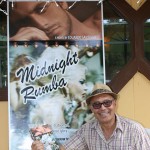An old tradition my forebears brought from Britain is the habit of bestowing names on their homes. It reached Idyllwild in the 1920s to such an extent that one issue of the Idyllwild Breezes newspaper carried a two-column poem, anonymously composed (possibly by Editor Joyce Carmichael), incorporating nearly forty examples.
Most commonly, these early house names embraced some feature of the natural landscape, such as vegetation (“Wayside Cedars,” “Burley Oak,” “Happy Oaks,” “Whispering Pines,” “Pine Nook,” “Seven Pines,” “Fern Haven”), or waterways (“Spring-Brook,” “Shadowbrook”) or both (“Alderbrook”). The local granite appeared in “Gray Boulders.”
A few owners advertised family origins: “Skogs Villan” (Swedish for “Forest Villa”), “Bide-a-Wee” (“Stay a While,” to Scots), and “Deseo del Corazon” (a Spanish “Heart’s Desire”). And there was the inevitable synthetic blend (“Casa Woodwardia”).
Lifestyles showed up in “Lazy Lodge,” “Camp-In,” “Cozy Nook,” “Trails End,” and “The Biltmore” (so named because it seemed to acquire an addition annually).
Some literary allusions turned up: “The House by the Side of the Road” and “Uncle Tom’s Cabin.” Less obvious was “The Chocolate Drop,” either an expression of personal taste or a commercial reference, given its location next door to the Idyllwild Inn.
And some simply opted for advertising the owner, as in “House of Bosworth,” or more creatively in “Eloc Lodge,” reversing the Cole family name.
Today, the naming tradition persists, and even casual observation harvests a satisfying crop of labels. Contemporary owners show a distinctly more creative bent. The use of a family name, for instance, is widespread, but now commonly coupled with an alliterative or rhyming noun, as in “Hoss’s Hideaway,” “Byers’ Back Lot,” or “Allgeier’s Shire.” The variety of nouns seems endless: den, corner, lodge, cabin, place, creekside, lair, chalet, cottage, even lily pad.
Among the more creative are “Cort House,” “Dave’s Awaysis,” and “Webb Site.” A family pet gained ownership in “Ruff Catt Lodge.”
Natural features continue to be popular: “Moon Mist,” “Sunnydale,” “Stonybrook,” “Brooksong,” “Creek Cottage,” “Pine Nest,” “Lily Vista,” “Happy Rock,” “Tree House,” “Timberest,” “Wind-Song,” and the apt but overused “On the Rocks.”
Foreign expressions now reach further afield. There is a “Casa de Calma,” but also “Ki-I-Wah” (helpfully translated from native tongue by the owner as “The Place That Waits For You”), and “Dom Tatry” (apparently evoking a house in the northern mountains of Slovakia).
Variations on our village’s name abound: “Idyll Eagle’s Nest,” “Hide Awhile,” “Idyll-a-while,” even “Wylld Lily Gardens.”
When it comes to lifestyle we may find ultimate peace in “Nirvana,”“A Bit of Heaven,” or “Mountain Om.” Then it’s back down to earth with “Hodgepodgelodge,” “Daisy Digger Lodge,” and “Whistling Pig Retreat.” A touch of the salacious colors “Naughty Pine,” “Shack Up On the Hill,” or “Bunny Stop” (the latter reputedly once owned by Hugh Hefner).
I cease trying to categorize in the face of labels like “McCabin,” “Alabama West,” “Monticello,” or the simply reassuring “Here ’Tis.”
My all-time favorite expression of Idyllwild living, however, goes to this weird marriage of Latin and Spanish: “Carpe Mañana.” Let us indeed be quick to seize the possibilities of … well, maybe tomorrow.
Finally, in naming our cabin out in Pinewood, Adele and I couldn’t resist indulging in some wordplay. To honor that community’s creator, my grandfather Frank Moote, an attorney with a keen sense of humor, we invented a pretentious phrase worthy of a developer: “Moote Pointe.”
These examples hardly scratch the surface of what a complete census of house names might reveal. But they amply reflect the individuality of Idyllwild’s homes and the creativity of its population throughout our village’s history.











I have thoroughly enjoyed reading this article. that's an awesome you did Robert Smith.
"Carpe Manana" is my sister's place. Her friend coined the phrase, and I had the sign made in the mid-90's as a Christmas present…